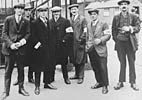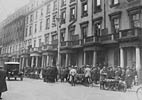The General Strike was a remarkable achievement demonstrating the innate strength of working class solidarity. However, the wake of the strike witnessed a crushing defeat for the mass movement from which it took at least a decade to recover.
Apart from the crushing blow to the miners there was widespread victimisation in many industries especially printing and railways. Trade union funds had dropped by £4 million by the end of 1926 and trade union membership fell by over half a million in 1927 alone.
Capitalising on its victory, Government reaction was punitive. It rushed through Parliament the Trades Disputes and Trades Union Act in 1927 by which general strikes and most sympathy strikes became illegal. The Act also outlawed the automatic political levy from members whose trade union was affiliated to the Labour Party, and instead introduced the requirement to 'contract in'.
Prompted by the TUC, and following the example of the Labour Party, many unions now invoked bans and proscriptions against communists holding office and showed open hostility to the Minority Movement. This reached new depths in 1929 when the General Council published its 'Inquiry into Disruption' which alleged that disruptive activities in the trade union movement were the work of communists under orders from Moscow.
Meanwhile the TUC embarked on a new course. The lesson it learned from the General Strike was that the conflictual model of industrial relations must be replaced by one that sought to remove the causes of disputes and establish a mechanism for their speedy resolution. The TUC wrote to employers' organisations suggesting joint discussions along these lines. Alfred Mond and 21 other employers mainly in the newer industries responded favourably and in 1928 the Mond-Turner talks began. (Ben Turner was Chair of the TUC General Council in 1928.) The main employers' organisations representing the older industries overwhelmingly rejected the Mond-Turner proposals.
Professor Mary Davis, Centre for Trade Union Studies, London Metropolitan University
Click here to view documents and pictures









